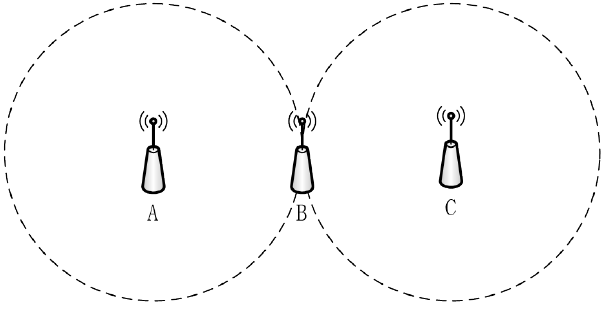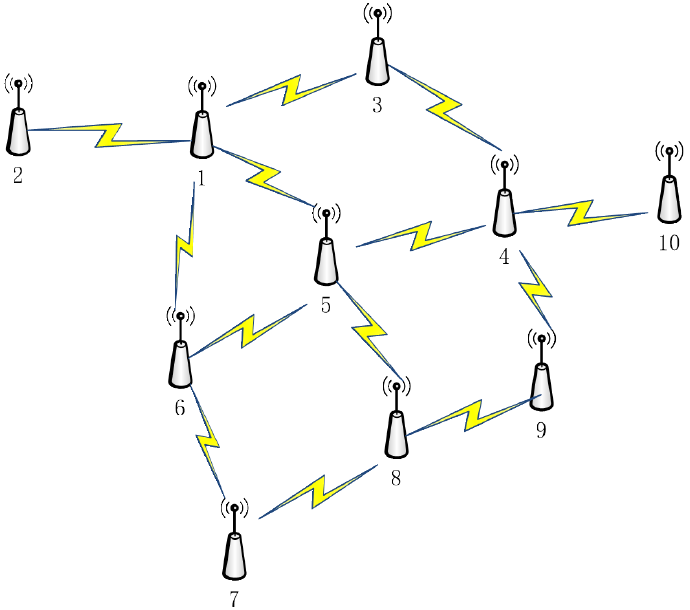Space Time Division Multiplexing Technical Description
Background
The traditional MESH wireless ad hoc network communication system transmits data based on time division multiplexing (TDM). In order to avoid interference, two or more nodes are not allowed to transmit at the same time in the same time slot. One node acts as the sender for data transmission, and other nodes are in the receiving state, which restricts the overall throughput of the network to a certain extent.
Technical Realization
According to the characteristics of wireless signal propagation in space, its signal strength will continue to attenuate with the increase of transmission distance. When the distance between two nodes is far enough, it can be considered that the transmitted signal of one node will not affect the reception of another node. Space Time Division Multiplexing (STDM) technology is based on the above characteristics, using the entire network topology information of the wireless ad hoc network, on the premise of ensuring a sufficiently safe transmission distance, and making full use of the spatial isolation between nodes on the transmission link. On the premise that the sending and receiving do not interfere with each other, the same time slot can allow two or more nodes to transmit at the same time, so that the wireless relay channel resources can be multiplexed based on the space interval. Compared with the traditional strict time division multiplexing (TDM) mode, the transmission bandwidth of the multi-hop relay link in STDM mode can be continuously consumed without being affected by the number of hops, thereby improving the throughput of network transmission.
To implement space and time division multiplexing, the multiplexing nodes must meet an interval of three hops or more. If there are only two hops apart, as shown in the following figure:

The three nodes A, B, and C form a two-hop topology. When A transmits a signal, B can monitor A’s signal, but C cannot. If C also transmits a signal, it will interfere with B’s reception of A’s signal. This is wireless communication,Hidden terminal problem in the system.

In the above figure, ABCD constitutes a 3-hop topology. When A transmits a signal, B cannot receive the signal transmitted by D, so B’s reception of A’s signal will not be affected. At this time, A and D can transmit signals at the same time, that is, using The same time slot resource can achieve the effect of time division resource multiplexing through spatial isolation, thereby improving the throughput of the network.
Scenes to be used
According to the above description, to realize space time division multiplexing, the interval between multiplexing nodes must be 3 hops or more. When there are less than 3 hops between the two farthest nodes in the MESH network, the effect of multiplexing cannot be achieved.
The following describes the multiplexing effect in several common scenarios.
1.Three-hop topology
According to the above description, at least 3 hops can be used for multiplexing, such as the 3-hop chain topology composed of four nodes in the following figure.

The four nodes A, B, C, and D are separated by a certain transmission distance in spatial distribution. The four nodes form a 3-hop chain network topology such as A-B-C-D. “-” means that adjacent nodes can send and receive signals to each other. Due to the space interval factor of the location of the node, at the same time, the signal sent by node A to node B will not affect the signal sent by node C to receive the signal sent by node D. A and D can reuse the same time slot resources.
When A sends a one-way data service to D, the three nodes of ABC all have corresponding transmission time slots. Since the distance between the three nodes of ABC is less than 3 hops, the occupied resources do not overlap with each other. Since D only receives, so A to The rate of D is 1/3 of the peak rate of a single hop (the three nodes A, B, and C each occupy 1/3 of the time slot resources).
If A sends data to B, and D sends data to C at the same time, since A and D can multiplex the same time slot, both nodes can occupy the time slot resources of the entire network. At this time, the rate from A to B, or D The rate to C can reach the peak value. In the case of not using spatial multiplexing, A and D can only use half of the resources, and the rate can only reach half of the peak value.
Therefore, in the above topology, as long as A and D have sending services, they can reuse the same resources, thereby improving the network throughput.
2.Multi-hop chain topology

5 Hopping topology
In the above figure, ABCDEF constitutes a 5-hop chain topology. In the case where space time division multiplexing is not enabled, if A sends data services to F, the ABCDE nodes all need to send data, so they need to occupy different time slot resources. The rate from A to F is 1/5 of the peak rate of a single hop; if the space time division multiplexing function is enabled, since D can reuse the time slot resources of A, and E can reuse the time slot resources of B, only three resources are actually needed, namely AD, BE and C each have one copy. At this time, the rate from A to F will reach 1/3 of the peak rate, which greatly improves the network throughput.
In this chain topology, when the number of hops increases, the subsequent nodes can always reuse the resources of the first three-hop nodes, so the one-way rate is basically maintained at 1/3 of the peak rate. Otherwise, when the multiplexing is not enabled , the one-way rate will only reach 1/N of the peak rate, where N represents the number of hops between the sending and receiving end nodes.
3.Hybrid topology
The actual MESH network is more complex than the chain topology, such as the topology in the following figure:

The route between nodes is not just a simple chain, there can be multiple routes in the middle, for example, the route between 2 nodes and 7 nodes can be 2167 or 21587. The multiplexing relationship between nodes also becomes more diverse according to the complexity of the topology. For example, the node (2,4,7) can be a multiplexing combination, and (2,8,10) can also be a multiplexing combination, as long as the nodes are between The same resources can be reused if the interval of 3 hops or more is satisfied. It should be noted that although (2,4,7) can multiplex the same time slot, the multiplexing resources used by three nodes as (2,8,10) cannot be used by (4,7) because 4,7 With 8 nodes does not meet the 3-hop limit.
The spatial time division multiplexing algorithm will use the topology information of the entire network to optimize the multiplexing combination according to the time slot resources required by each node, that is, use the least resources to meet the business needs of all nodes, thereby maximizing the network throughput.
